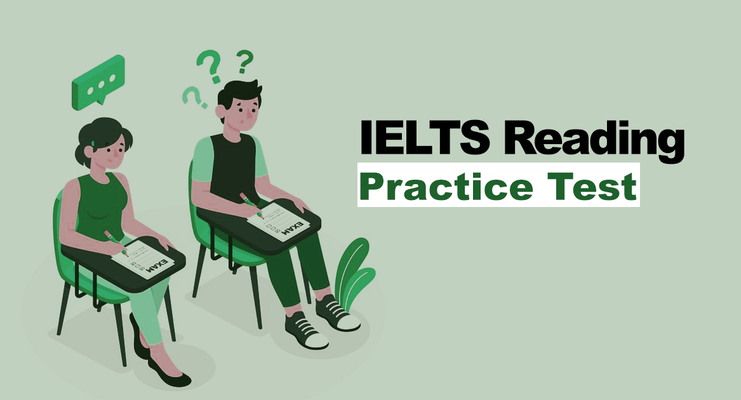IELTS Reading Practice Test
6 mins read 1389 Views
By Prabhadri Suman|Updated On - 2023-12-17 17:39:28
Enhance your IELTS reading skills with these proven strategies for the practice test. Boost your score and achieve success in the IELTS exam.

Topics Covered:
- IELTS Reading Test Overview
- IELTS Reading Sample Papers
- IELTS Academic Reading Practice Test
- IELTS General Training Reading Practice Test
- Computer-delivered IELTS Reading Practice Test
- IELTS Reading Practice Test Based on Question Types
- IELTS Reading Practice Test Example
- Tips to Improve IELTS Reading Skills
- Conclusion
Are you preparing for the IELTS exam and looking for ways to improve your reading skills? You've come to the right place! In this comprehensive guide, we will explore various IELTS reading practice tests that will help you boost your score. Whether you are taking the Academic or General Training module, these practice tests will provide you with valuable insights into the format and types of questions you can expect on the actual exam.
IELTS reading is one of the more challenging modules for any test taker. You have a limited time in which to read and understand an academic-level document. Understanding that process effectively and quickly will help you succeed in this section of your IELTS exam , as well as in your future studies or career.
IELTS Reading Test Overview
The IELTS reading test assesses your reading comprehension skills in an academic or general training context. The academic reading test is designed for individuals applying for higher education programs, while the general training reading test is tailored for those seeking work or immigration opportunities. Both tests consist of three sections, each containing a different reading passage followed by a series of questions.
Academic Reading Test
The academic reading test evaluates your ability to understand and analyze complex texts. The passages are sourced from journals, newspapers, and magazines, targeting non-specialist audiences. The topics covered in the passages are diverse and relate to various academic disciplines. You'll encounter question types such as multiple-choice, sentence completion, table completion, and more.
General Training Reading Test
The general training reading test assesses your ability to comprehend texts in everyday situations. The passages are more practical in nature and focus on topics relevant to work, daily life, and general interest. The question types include matching information, matching sentence endings, and completing forms or summaries.
IELTS Reading Sample Papers
To begin your IELTS reading preparation, it is essential to familiarize yourself with the IELTS reading sample papers. These papers contain carefully selected reading passages that reflect the difficulty level and topics covered in the actual exam. By solving these practice questions, you can assess your readiness for the exam and identify areas where you need improvement.
These IELTS reading practice tests are designed to simulate the actual exam experience and provide you with ample practice opportunities to hone your reading skills. As you work through these tests, make sure to time yourself to develop your time management skills.
IELTS Academic Reading Practice Test
If you are taking the Academic module of the IELTS exam, the Academic Reading Practice Test is a valuable resource for your preparation. This test consists of three sections, each containing a long text of approximately 2,150-2,750 words. The passages are sourced from journals, newspapers, and magazines, covering topics of general interest.
The Academic Reading Practice Test assesses your ability to comprehend and analyze complex texts, understand the writer's opinion and attitude, and answer a variety of question types. These question types include multiple-choice questions, sentence/note completion questions, table completion questions, and short answer questions.
To maximize your performance on the Academic Reading Practice Test, follow these tips:
- Skim the passage: Before diving into the questions, quickly read the passage to get an overall understanding of the topic and main ideas.
- Highlight keywords: Identify keywords and phrases as you read the questions to help you locate the relevant information in the passage more efficiently.
- Pay attention to instructions: Read the instructions for each question type carefully to ensure you understand what is required.
- Manage your time: Allocate time for each section and stick to it to ensure you have enough time to answer all the questions.
- Practice active reading: Engage with the text by underlining key information, summarizing paragraphs, and making connections between ideas.
By following these strategies and practicing with the Academic Reading Practice Test, you will build the necessary skills and confidence to excel on the IELTS Academic reading section.
IELTS General Training Reading Practice Test
If you are taking the General Training module of the IELTS exam, the General Training Reading Practice Test is tailored to your specific needs. The test consists of three sections, each containing passages that reflect real-life situations and texts you may encounter in an English-speaking environment.
The General Training Reading Practice Test assesses your ability to read and understand practical texts, such as advertisements, job descriptions, and everyday materials. The question types in this test include multiple-choice questions, sentence completion questions, matching information questions, and short answer questions.
To make the most of your General Training Reading Practice Test, consider these tips:
- Understand the purpose of the text: Determine why the text was written and what information it aims to convey. This will help you answer questions related to the main idea and specific details.
- Pay attention to tone and style: Notice the tone and style of the text, as they can provide clues about the writer's attitude or purpose.
- Use context clues: If you come across unfamiliar words or phrases, use the context to infer their meaning.
- Practice skimming and scanning: Develop your skimming and scanning skills to locate relevant information in the passages quickly.
- Read instructions carefully: Ensure you understand the requirements of each question type and provide the requested information accurately.
By practicing with the General Training Reading Practice Test and implementing these strategies, you will enhance your reading abilities and increase your chances of success on the IELTS General Training reading section.
Computer-delivered IELTS Reading Practice Test
For those taking the computer-delivered version of the IELTS exam, the Computer-delivered IELTS Reading Practice Test is an excellent resource to familiarize yourself with the digital format. This test allows you to practice on your own computer, simulating the actual test environment.
The Computer-delivered IELTS Reading Practice Test consists of various question types, including multiple-choice, note completion, matching sentence endings, sentence completion, identifying information, matching headings, summary completion, and flowchart completion. It is crucial to become comfortable with navigating through the test interface and answering questions efficiently.
To succeed on the Computer-delivered IELTS Reading Practice Test, remember these tips:
- Familiarize yourself with the test interface: Spend time understanding how to navigate through the test, mark answers, and review your responses.
- Manage your time effectively: Practice allocating time for each section and question type to ensure you can complete the test within the given time limit.
- Use the highlighting and note-taking features: Take advantage of the digital tools available, such as highlighting important information and making notes as you read the passages.
- Practice typing your answers: Get accustomed to typing your answers instead of writing them by hand. Pay attention to spelling and grammar to ensure your responses are accurate.
- Review your answers: Utilize the review feature to go back and check your answers before submitting the test.
By practicing with the Computer-delivered IELTS Reading Practice Test, you will gain confidence in using the digital platform and optimize your performance on the computer-delivered IELTS reading section.
IELTS Reading Practice Test Based on Question Types
To further enhance your reading skills and familiarize yourself with the different question types on the IELTS exam, let's delve into the various question types you may encounter during the reading section.
Multiple-Choice Questions
Multiple-choice questions require you to choose the correct option from a list of choices. To excel in this question type, carefully read the question and options, paying attention to keywords and context clues. Practice answering multiple-choice questions from various IELTS reading sample papers to improve your accuracy.
Sentence/Note Completion Questions
In sentence/note completion questions, you must complete an incomplete sentence or note based on the information provided in the passage. Focus on the context and keywords to determine the most appropriate word or phrase to fill the gap.
Complete the Table Type Questions
Complete the table type questions require you to fill in a table with information taken from the passage. Carefully read the questions and corresponding sections of the passage to extract the necessary information and complete the table accurately.
Short Answer Type Questions
Short answer type questions require you to provide brief answers based on the information in the passage. Ensure your answers are concise and directly address the question. Pay attention to word limits and spelling to maximize your score.
Label the Diagram Type of Questions
Label the diagram type questions assess your ability to comprehend and apply information from the passage to complete a labeled diagram. Analyze the relevant section of the passage and use your understanding to label the diagram accurately.
Matching Type Questions
Matching type questions come in various forms, such as matching the sentence endings, matching the features, and matching the headings. Read the instructions carefully and refer back to the passage to find the corresponding matches. Pay attention to the order and ensure your selections accurately represent the information provided.
Complete the Summary Type Questions
Complete the summary type questions require you to fill in missing information in a summary based on the passage. Understand the main ideas and supporting details in the passage to complete the summary effectively.
True/False/Not Given or Yes/No/Not Given
True/False/Not Given or Yes/No/Not Given questions evaluate your ability to comprehend the writer's opinion and attitude. Read the statements carefully and refer back to the passage to determine whether the information is true, false, or not given.
By familiarizing yourself with these question types and practicing with IELTS reading sample papers, you will develop the necessary skills to tackle any question that may appear on the reading section of the IELTS exam.
IELTS Reading Practice Test Example
The Braille System The Braille system is a contact reading and writing device for the blind where the dots indicate the letters and numbers. It also has dots for punctuation marks and markers for showing letter groupings. Braille is read by running their hands through each line from the left side. Reading is usually done using both the hands, with the index fingers doing most of the work. On average, the reading pace is approximately 125 words per minute. Some people can read at faster rates of up to 200 words a minute. Blind people will learn about the written word while using the braille alphabet. They will also learn things like pronunciation, punctuation, paragraph formatting, and footnotes. Most importantly, braille gives blind people access to a wide variety of items, including leisure and instructional reading, income reports, restaurant menus and critical things in everyday adult life like contracts, laws, insurance plans, indexes, and cookbooks. Using materials such as musical scores, songbooks, card games, and chess, blind people will also enjoy activities and cultural stimulation through braille. Many other methods have been tried over the years to help blind people to read. Many of those were elevated copies of print letters. The braille scheme became a success because it is made on a logical series of signs intended for the fingertips instead of imitating signs designed for the eyes. Braille has a long tradition that dates back to the beginning of the 18th century. In Bonaparte’s French army, a man named Charles Barbier invented a unique technique known as “night printing” so soldiers could talk peacefully at night. Barbier, a veteran of the military, saw the deaths of several troops who used lights after dark to understand battle signals. Because of the light from the torches, enemy combatants realised where the French soldiers were, causing the death of several men. Barbier’s “night printing” technique is made on an elevated 12-dot cell that is 2 dots wide and 6 dots deep. Inside the cell, each dot or mixture of dots denoted a letter or phonetic sound. The issue with the legal regulations was that the normal fingertip did not recognise any of the dots with a single touch. Louis Braille was born in a French village called Coupvray on Jan 4, 1809. He went blind at a young age after accidently stabbing himself in the eye with his father’s blade. Braille’s father was a leather maker who used a tool to punch holes in the leather goods he made. At the age of 11, Braille was inspired to change Charles Barbier’s “night printing” code to make an effective written correspondence device for all the blind people. He had joined the National Institute of the Blind in Paris a year before. He spent the best part of the next 9 years designing and making a perfect pattern of raised dots that bears his signature, Braille. With all of Braille’s efforts, the coding was now directed on cells of just 6 dots rather than 12. This crucial advancement meant that a fingertip could cover the entire cell unit with a single impression and travel quickly from one cell to the next. Braille eventually gained acceptance around the world as the main mode of written communication for blind people. Even today, there is no difference in the braille system from what he invented. However, some small changes have been made to the braille system, most notably the addition of contractions describing groups of letters or entire words that occur regularly in a script. Contractions allow for easier braille reading. It also helped to reduce the scale of braille books, making them even lighter. In 1853 Braille passed away, at the age of 43, a year before his native France adopted braille as the official correspondence method for the blind. In 1860, Braille made its way “across the pond” to America, where it was used by The Missouri School for the Blind in St. Louis. The legacy of Louis Braille has enriched the lives of millions of people who are blind. As a consequence, blind people from around the world learn from Braille’s work on a regular basis. Today, braille code has been transposed in a variety of languages all over the world. Braille will be proud to know that his work has helped many people get literacy over the years. The effect is largely inspiring and helps them to achieve success in their academics and their career paths.
The Braille System IELTS reading questions Questions 1 – 5
Complete the sentences below.
Choose NO MORE THAN TWO WORDS AND/OR A NUMBERS from the passage for each answer.
1 The Braille system is a contact reading and writing device for the blind where the ________ indicates the letters and numbers.
2 The braille scheme became a success because it is made on a logical series of signs intended for the ________ instead of imitating signs designed for the eyes.
3 Braille eventually gained acceptance around the world as the main mode of ________ for blind people.
4 Braille code has been transposed in a variety of ________ all over the world.
5 The issue with the ________ was that the normal fingertip did not recognise any of the dots with a single touch.
Questions 6 - 10
Do the following statements agree with the information given in the Reading Passage?
Write YES: if the statement agrees with the claims of the writer
NO: if the statement contradicts the claims of the writer
NOT GIVEN: if it is impossible to say what the writer thinks about this
6 The average speed of reading using Braille is 125 words per minute.
7 Braille cannot be used for reading contracts, laws, insurance plans, indexes, and cookbooks
8 Braille died in 1835 at the age of 43.
9 Braille’s father was a leather maker.
10 Contractions allow for easier braille reading and help to reduce the scale of braille books, making them even lighter.
Questions 11-15
Complete the summary below.
Write NO MORE THAN TWO WORDS from the passage for each answer.
Louis Braille was born in a French village called 11 ____ on Jan 4, 1809. With Braille’s efforts, the coding was directed on cells of just 12 ____ rather than 12. Blind people from around the world learn from Braille’s work on a regular basis. It gave access to a wide variety of everyday items, including leisure and 13 ____ reading, income reports, restaurant menus and critical things. Today, 14 ____ has been transposed in a variety of languages all over the world. In 1853 Braille 15 ____, at the age of 43.
Computer Security
Since the businesses are more and more relying on information and associated information systems (IS) as well as using information technology (IT) a lot changes the problem of computer security over a period of time. Still, there are only small changes occured in the security or safeguards implemented in the information systems. Even identifying the required securities and policies is not able to be done by most of the executives.
A. In the span of July 1991 - July 1996, the internet users from the commercial sector had increased from 33% to 50%. It shows how the internet becomes an important factor for business growth. Generally, the size of the internet approximately doubles each year and the related security incidents have been running in parity. Though the malicious users’ percentage is less, the number of failed security incidents is significantly larger since the size of the internet is increased.
B. In network, the morris worm was entered into the Internet which invaded, attacked and replicated itself, in 1998. To fix this problem, Both Email and connectivity has been shut down. But, still, the fixes were to be distributed through Email and so the solution doesn’t serve the purpose. Consequently, In 1992, CERT (Computer Emergency Response Team) with the Australian version (AUSCERT) was formed to tackle the worm virus.
C. The problem with Internet security is that malicious incidents are increasing in complexity. The increasing availability of toolkits has become one of the reasons for it. Actually, the toolkits are made for the computer systems designers to guard and develop their sites. But, it turns out to be helpful for those ignorant intruders to execute the intended complex incidents by using many routers and disguises. A US Department of Defence report says that the incidents which have happened are less than 1% but 65% of those are successful. One thing that we should keep in mind is that hackers and intruders don't fit into the geographical, administrative boundaries or time zones. The reason might be they have been geographically dislocated during the attack. Therefore, they must be operating ‘off-duty hours’.
D. The key thing to understand here is that system administrators should get it right all the time but the intruder should get it right just once. Evidence will be easier to find for this. In 1997, a Bell Atlantic Network was hacked by the teenager. As a result of his hacking, the computer crashed and 600 homes, a regional airport and emergency services became without telephone communication for six hours. Punishment for this offence is as follows, Two years probation, community service and a fine of US$5,000.
E. From the wake of September 11, Governments started to take sincere action against cyber crimes. It is found that crimes are being connected to national security, which becomes a prime concern for both government officials and the public. The government took action faster. The US Patriot Act was introduced in late 2001. This Act increased the maximum punishment of five to ten years for those who break into computers. Then in July 2002, the House of Representatives sanctioned the Cyber Security Enhancement Act. If the act of the cyber crime by an offender causes the death of an individual, he will be condemned to life sentence. After the September 11 attacks, the FBI and other government agencies elevated their monitoring of the internet. This becomes the reason for the disappearance of hackers as their act no longer considered as a play or challenge, but terrorism.
F. On the other side, September 11 events caused some ex-hackers to use their broad knowledge, skills and experience to coordinate with the security forces to help the fight against terrorism.
G. Computer viruses and hacking incidents continue even after the punishment threats are increased. Long-time security measures which have been implemented by companies and individuals are not fail-safe. Firewalls are one of the prime IS security measures. It filters the entering data and leaves the corporate IS. Though the firewalls have a number of advantages, it will not be a total cure for all 18 security woes, just an enhancement. It will only offer a false sense of security and just provide a minimal amount of protection against internal attackers. In a nutshell, the corporate world needs to realise that computer security will be an on-going problem and expense.
Computer Security IELTS Reading Questions
Questions 16-22 The reading passage has six paragraphs:
A-G. Choose the correct heading for each paragraph from the list of headings below.
Write the correct number, i-x, as your answer to each question.
List of Headings
i. Activities of hackers and intruders
ii. Importance of Internet
iii. Computer security and its features
iv. The Process of Hacking
v. How Government fight against cyber crimes
vi. The Morris Worm
vii. Intruders can easily hack
viii. How firewall performs
ix. Ex-hackers and fight against terrorism
x. Secret of Effective computer security
16. Paragraph A
17. Paragraph B
18. Paragraph C
19. Paragraph D
20. Paragraph E
21. Paragraph F
22. Paragraph G
Tips to Improve IELTS Reading Skills
In addition to practising with IELTS reading practice tests, it is essential to incorporate effective strategies into your preparation routine. Here are some tips to improve your IELTS reading skills:
- Develop a reading habit: Read various English materials, such as newspapers, magazines, and books, to expose yourself to different writing styles and topics. This will help expand your vocabulary and improve your reading speed.
- Focus on skimming and scanning: Practice skimming the passage to understand the topic and scanning for specific information. These techniques will help you locate relevant details quickly.
- Build your vocabulary: Learn new words and their meanings to enhance your comprehension of the passage. Make a habit of noting down unfamiliar words and reviewing them regularly.
- Practice time management: Set a timer for each practice test and work on completing the passages and questions within the given time limit. This will help you improve your speed and accuracy.
- Take notes: As you read the passage, briefly note the main ideas, supporting details, and any important information. This will help you remember and refer to the content when answering questions.
- Review incorrect answers: After completing a practice test, review the questions you answered incorrectly and understand why you made the mistake. This will help you identify your weaknesses and focus on improving them.
By incorporating these tips into your IELTS reading practice, you will gradually improve your reading skills and increase your chances of achieving a high score on the exam.
Helpful calculator to Calculate ==> CGPA to Percentage
Conclusion
Preparing for the IELTS reading section requires dedicated practice and effective strategies. By utilizing the IELTS reading practice tests, understanding the question types, and implementing the tips provided, you will develop the necessary skills to succeed on the reading section of the exam. Remember to practice consistently and maintain a positive mindset throughout your preparation journey. With determination and perseverance, you can achieve your desired score in the IELTS reading section. Good luck!
The Edmissions team is available to offer assistance throughout the process of applying to
study abroad
. Prior to submitting your application to your preferred college or university, it is advisable to contact an Edmissions specialist by registering on the website
edmissions.com
.
To learn more about application processing, contact our Edmissions specialists at
[email protected]
.
For a quick overview related to study abroad,
click here
Latest Blog Posts
Trending Posts

Exam
2024-02-12 06:51:51
7833 Views
Popular Colleges to Study Abroad
Blog FAQ's
Top Study Abroad Exams
Popular Universities to Study Abroad
- University of Waterloo
Waterloo
- University Canada West
Vancouver
- University of Windsor
Windsor
- Cape Breton University
Sydney
- Dalhusie University
Halifax
- Carleton University
Ottawa
- University of Ottawa
Ottawa
- University of Guelph
Guelph
- Explore more colleges in Canada
- University of New Haven
West Haven
- Kent State University
Kent
- Wright State University
Dayon
- San Jose State University
West Haven
- Clark University
Worcester
- Rowan University
Glassboro
- Golden Gate University
San Francisco
- Arkansas
San Francisco
- Explore more colleges in USA
- Coventry University
Coventry
- University of Birminghame
Birminghame
- De Montfort University
Leicester
- Cardiff University
Cardiff
- BPP University
London
- University of West London
London
- University of Nottingham
Nottingham
- University of Warwick
Coventry
- Explore more colleges in UK
- Auckland Institute Of Studies
Auckland
- Massey University - Auckland Campus
Albany
- Eastern Institute of Technology - Auckland Campus
Auckland
- NorthTec - Auckland Campus
Auckland
- Massey University - Manawatu Campus
Palmerston North
- University of West London
London
- Wellington Institute of Technology (WelTec) - Petone Campus
Lower Hutt
- Otago Polytechnic - Dunedin Campus
Dunedin
- Explore more colleges in New Zealand
- Chandigarh University
Mohali
- Parul University
Vadodara
- Sharda University
Greater Noida
- Jain University
Bangalore
- Bennett University
Greater Noida
- Lovely Professional University
Phagwara
- Chitkara University
Rajpura
- Brainware University
Kolkata
- Explore more colleges in India
- Abu Dhabi University
Abu Dhabi
- Gulf Medical University
Ajman
- New York University
Abu Dhabi
- Emirates Aviation University
Dubai
- Higher Colleges of Technology
Dubai
- British University in Dubai
Dubai
- Al Ghurair University
Dubai
- American University in the Emirates
Dubai
- Rochester Institute Of Technology Dubai
Dubai
- Emirates Academy of Hospitality Management
Dubai
- American University of Ras Al Khaimah
Ras Al Khaimah
- Explore more colleges in UAE
- Ras Al Khaimah Medical and Health Sciences University
Ras Al Khaimah
Search, Shortlist, Apply and get accepted! It’s that Simple to pursue your dream to Study abroad with Edmissions. Our team of experts provide you the right guidance that helps you to take admission in your dream college in countries like Canada, the USA, the UK
© 2021-2024 Edmissions - All rights reserved.
TALK TO OUR EXPERTS










